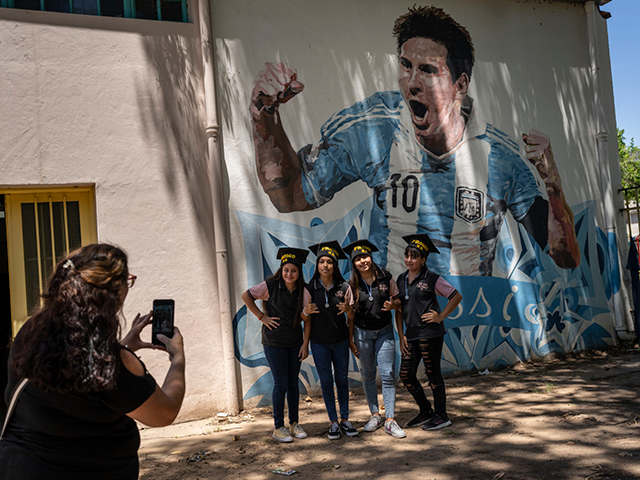Argentina obtained its long sought-after third FIFA World Cup victory on Sunday, leaving the nation’s leftist government to pay back its promise to solve inflation only after the Cup returned to Buenos Aires.
The socialist government of President Alberto Fernández had in the past dismissed fighting inflation as less important than the soccer trophy and suggested that the entire nation must focus on supporting athletes before its economists could help wage its self-declared “war on inflation.” The South American nation finds itself poised to end 2022 with an accumulated interannual inflation rate hovering at 100 percent, and with 43 percent of its 45.8 million citizens living below the poverty line.
On November 13, one week before the start of the 2022 FIFA World Cup held in Qatar, Argentina’s Minister of Labor, Employment, and Social Security Kelly Olmos stated during an interview, “We’ll keep working on inflation later, but first let Argentina win.” Olmos had been asked what she would choose if given the change to tame Argentina’s rampant inflation rate or for her country to win the World Cup.
Argentina won the trophy on December 18 against incumbent champion France, ending the country’s 36-year drought in soccer’s most important tournament after previously winning it in 1978 and 1986.
At the time of Olmos’ interview, Argentina’s inflation rate during October had been measured at 6.3 percent, bringing the nation’s accumulated interannual inflation rate to 88 percent. Experts and analysts had forecasted in November that Argentina would soon breach the 100 percent inflation threshold, closing 2022 with a 101.5 percent interannual inflation.

Argentina’s Lionel Messi holds up the trophy after winning the World Cup final soccer match between Argentina and France at the Lusail Stadium in Lusail, Qatar, Sunday, December 18, 2022. (AP Photo/Manu Fernandez)
Argentina’s leftist government, in an effort to forestall the continued growth of inflation and bring it down to four percent per month, imposed new price control caps across 1,788 different products for a period of 120 days, from November 2022 until February 2023.
The nation’s inflation rate during November was measured at 4.9 percent — 1.4 percent down from October’s 6.3 percent. It was still the second highest inflation in the region during that month, surpassed only by socialist Venezuela’s 21.9 percent inflation rate in November, according to independent sources, as the Maduro regime does not publish official accurate data.
Despite Argentina’s November inflation rate being lower than the preceding months, it now has an accumulated inflation rate of 92.4 as of the end of November, which places the South American nation only behind Zimbabwe, Venezuela, and Lebanon as the country with the fourth highest inflation rate during 2022.
Argentine Economy Minister Sergio Massa explained via an interview given to Buenos Aires’ Radio 10 on Friday, “The goal is for inflation to reach three percent [in April 2023].”
“We are still not happy with the number, which is still high for what we intend to recover [in] purchasing power,” Massa commented. “To recover purchasing power, income must be recovered and, at the same time, lower inflation.”
From the perspective of an Argentine consumer, the reduction in inflation during November ended up as a zero-sum in their already diminished purchasing power, as the reduction in food price inflation was offset by a reduction of public utilities subsidies.
Mexican newspaper El Economista reported on Thursday that, according to data from the Organization for Economic Co-operation and Development (OCDE), food price inflation in Argentina had reached 91.59 percent as of October, the highest in 48 years and the second-highest registered food inflation rate out of the organization’s 38 member countries in 2022, surpassed only by Turkey’s 99.05 percent.
One month after the “Fair Price” fixing scheme, the Argentine government expanded its price controls, applying price caps to key industrial supplies such as aluminum, glass, petrochemicals, and containers. These caps will not allow prices to rise above four percent per month and will be valid from December 2022 until March 2023.
Argentina, which joined China’s predatory Belt and Road Initiative (BRI) in February 2022, negotiated a $5 billion currency swap extension with communist China in an effort to boost the nation’s dwindling foreign reserves, which, according to the the Central Bank of Argentina, are at $6.8 billion as of December 14.
In another last-ditch effort to boost its near-dry foreign reserves, the government of Argentina announced a new version of the “Soy Dollar,” a new tier in the nation’s highly convoluted foreign currency exchange system that gives a preferential exchange rate of 230 Argentine pesos per United States dollar to soybean exporters, an amount that is 33 percent higher than the official rate of 172 Argentine pesos per dollar. In contrast, one United States dollar is worth 321 Argentine pesos through the non-official exchange rate locally referred to as Dólar Blue as of Monday.
The South American nation is expected to receive $5.9 billion from the International Monetary Fund this week, which would give a brief respite to Argentina’s foreign reserves.
Christian K. Caruzo is a Venezuelan writer and documents life under socialism. You can follow him on Twitter here.


COMMENTS
Please let us know if you're having issues with commenting.